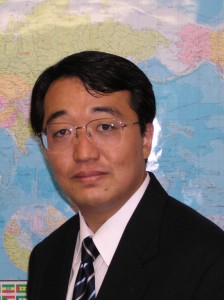緊張と統合:内村鑑三におけるキリスト教と日本の精神
このシリーズでは、私が1994年に執筆した統一神学大学院(Unification Theological Seminary)の神学課程修士論文(Divinity Thesis)を日英二か国語で掲載している。
今回から第5章の「無教会運動の構造」に入る。
5.無教会運動の構造
A.師弟関係に基づいた聖書研究会
無教会キリスト教は、禅と同じく、組織となることを拒否する。この二つは共に完全な個人の自由と、規定された形式からの独立を強調する。そこで当然「彼らは組織なくしてどうやって信仰を次の世代に伝えることが出来るのか?」という疑問が生ずるであろう。無教会運動の独特の組織構成は、日本文化に共通する型に言及することなしには、正しく理解されないであろう。なぜならそれは、日本的な伝統の土壌に深く根ざした人間関係の様式に型どられているからである。
西洋型のキリスト教会を日本に移植する上での主たる困難は、西洋で存在しているような教会という概念が日本においては全く欠如していることにある。宗教的目的と世俗の目的を融合させる傾向性のために、宗教を独立した特別の訓練と考えることは、日本人にとっては奇異なことであり、反発的にさえ映ったのである。無教会キリスト教の際だった特徴は、西洋型の教会なしにキリスト教の信仰に参与しようという試みにある。この目的は「聖書のみに忠実である」という流儀によって成し遂げられる。無教会の支持者たちは、「あぐら」クリスチャンと呼ばれ、彼らは「家の畳、工場、学校、そして教会以外ならどこにでもあぐらをかいて座り、聖書を学ぶのである。」
日本の社会においては、儒教の教えが道徳と社会行動を導くための教育上の原理として働き、寺院では教えられなかった社会生活上の構造を提示した。内村が指摘するように、「わが国にも坊主はいる、しかし彼らは元来、寺の管理人であって真理と永久不変の真実の教師ではない。すべてわれらの道徳的改革者は、学問芸術を教えながら実は霊的なことを教える『人生の教育者』なのであった。」このような先生主導の学校が教育的・宗教的な機能を両方とも果たしていたために、日本の上流階級の人々は、その社会的、道徳的、宗教的人格の全てを、この師弟関係の脈絡の中で形成していたのである。構造的な次元においては、無教会運動は日本の伝統に実に深く根ざしたこの師弟関係によって特徴づけられると言えるのである。
先生を中心とする聖書研究グループが、典型的な無教会の集会のスタイルである。
しかし教師は本質的に神の道具であり、教師に対しての正式な訓練や任命というものはない。聖霊を受けたと感ずる者は、誰でも彼自身の集会をつくり、聖書の教えを説きはじめることができる。
無教会の指導者たちは、この運動のいかなる組織の存在も否定しているが、実際には聖書研究会と、無教会信者の家庭で行われる非公式の集会という一般的なパターンがいくつか見受けられる。後者の場合には集会は大変小さく、親密な個人的関係が特徴となっている。組織は基本的に民主的である。すなわちメンバーは全員平等であり、聖書研究について平等の責任をもつと考えられている。しかし、実際にはその集会も高等教育を受け、聖書の内容にあかるい一、二の会員によって指導される場合が多い。
V. Structure of Mukyokai Movement
A. The Bible Study Group Based on Teacher-Pupil Relationship
Mukyokai Christianity, like Zen, refuses to be a system; both of them emphasize total personal freedom and independence of prescribed forms. Then, one may raise the question, “How can they transmit their faith to the next generation without organization?” It is impossible to understand the peculiar structure of the non-church movement without reference to the prevalent relational patterns in Japanese culture and society because it is patterned on a model of human relationship deeply rooted in the soil of Japanese tradition.(1)
The main difficulty to transplant the western type of Christian church to Japan is the entire lack of concept of the Church as it exists in the West. Because of a tendency to fuse the religious end and secular end, the concept of religion as a separate and special discipline was odd and even repulsive to the Japanese.(2)The distinctive characteristic of Mukyokai Christianity is its endeavor to take part in the Christian faith without the church of western type. Its mode of accomplishing this aim is found in “adherence to the Bible alone.”(3) Mukyokai adherents are called “cross-legged” Christians, who “sit cross-legged on straw mats in homes, factories, schools, and anywhere – except Churches -studying the Bible.”(4)
In Japanese society, Confucian doctrines served as educational principles to guide moral and social behavior and provide a structure for social life which could not be learned in the temple. As Uchimura points out, “priests we have, but they are essentially temple-keepers and not teachers of truth and eternal verities. All our moral reformers were teachers, ‘pedagogues’ who taught the things of the spirit while they taught letters and science.”(5) Since this teacher-oriented academies fulfilled both educational and religious functions, members of the upper Japanese class developed their entire social, moral, and religious personalities within the context of the student-teacher relationship.(6) On the structural level, the non-church movement is characterized by this teacher-pupil relationship so deeply rooted in Japanese tradition.
The Bible study group centering on sensei is the typical style of Mukyokai meeting, but the teacher is essentially an instrument of God and there is no formal training or assignment of responsibilities. Anyone who feels divinely inspired can form his own group and instruct in the Bible.(7)
Though the Mukyokai leaders deny the existence of any structure within the movement, a number of observation can be made about the general patterning of the Bible study groups and of the informal groups which meet at members’ homes. The latter are very small in size and characterized by intimate interpersonal relationships. The overall structure is highly democratic – all members are considered equal and have an equal responsibility in the teaching of the Bible. However, in practice, one or two members who are better educated and more articulated may come to dominate the group as the whole.(8)
(1)Ibid., p.117.
(2)Ibid., p.123.
(3)Carl Michalson, Japanese Contributions to Christian Theology, (Philadelphia: The Westminster Press), p.18.
(4)Ibid., p.20-21.
(5)op cit, Uchimura, Zenshu, p.XV, p.142.
(6)op cit, Caldarola, p.123.
(7)Ibid., p.124.
(8)Ibid., p.135.
